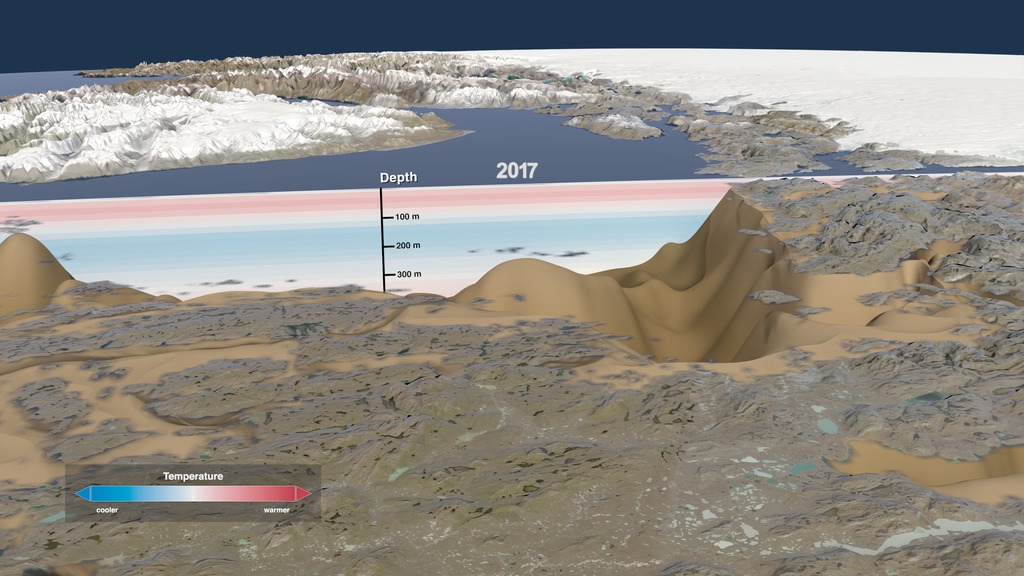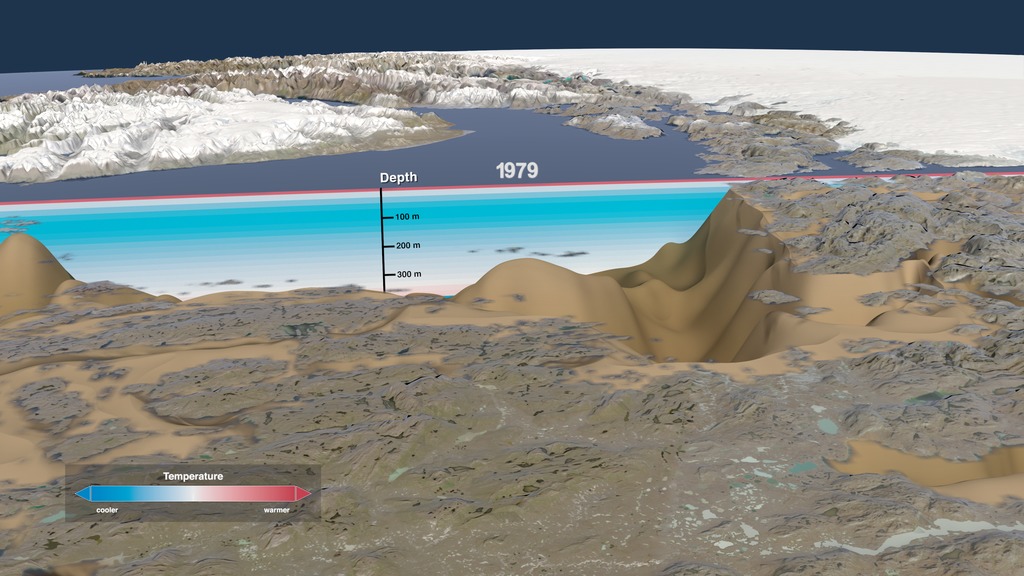Jakobshavn's Interrupted Thinning Explained
This visualization shows a variety of data from the oceans and ice to help explain why Jakobshavn glacier grew thicker and advanced between 2016 and 2017. Initially, the average flow of ice across the Greenland Ice Sheet in these years is shown as colored flow arrows, with blue shades indicating slower movement and red indicating faster. As we draw near we see a large bay named Disko Bay located just to the west of the narrow inlet, or fjord, that is home to Jakobshavn glacier. The water is cut away to reveal the historical temperature of the bay, to a depth of about 400 meters. Around Greenland, water below 150 m depth tends to be warmer than water near the surface. The change in temperature between 1952 and 2017 is shown using blue tones for colder water and red tones for warmer. The deep water warms through most of the 1990s, but cools dramatically after 2015. The ocean temperature changes are shown a second time, with a brief pause on 1979 to see the initial cooler water temperature, 2000 to view the warming and 2017 to view the current cooling trend.
The visualization pulls out to show the entire Greenland Ice Sheet while ocean is drained to reveal the shape and depth of the ocean floor around the ice sheet. Data from the ECCO ocean circulation model shows ocean currents carrying water around the southern tip of Greenland and up the west coast, where it eventually enters Disko Bay and reaches Jakboshavn glacier.
When we zoom in to the Jakobshavn glacier again, we see the glacier is blanketed by more than 40,000 radar observations. These data show the change in elevation between 2016 and 2017 as measured by an aircraft. These elevation changes are colored so that blue colors indicate an rise in the elevation and orange/red colors indicate a fall. The deepest blue color reflects the advance of the glacier from the 2016 front, appearing in the video as a shaded cliff, to its more advanced location in 2017. Farther downstream in the fjord the patches of blue and red show icebergs, which have detached from the front.








Used Elsewhere In
Visualization Credits
Lead Visualizer:
Cindy Starr (GST)
Visualizers:
Horace Mitchell (NASA/GSFC)
Greg Shirah (NASA/GSFC)
Scientists:
Josh Willis (JPL)
Ala Khazendar (JPL)
Ian Fenty (JPL)
Producer:
Kathryn Mersmann (USRA)
Project Support:
Joycelyn Thomson Jones (NASA/GSFC)
Leann Johnson (GST)
Eric Sokolowsky (GST)
Technical Support:
Laurence Schuler (ADNET Systems Inc.)
Ian Jones (ADNET Systems Inc.)
Cindy Starr (GST)
Visualizers:
Horace Mitchell (NASA/GSFC)
Greg Shirah (NASA/GSFC)
Scientists:
Josh Willis (JPL)
Ala Khazendar (JPL)
Ian Fenty (JPL)
Producer:
Kathryn Mersmann (USRA)
Project Support:
Joycelyn Thomson Jones (NASA/GSFC)
Leann Johnson (GST)
Eric Sokolowsky (GST)
Technical Support:
Laurence Schuler (ADNET Systems Inc.)
Ian Jones (ADNET Systems Inc.)
Please give credit for this item to:
NASA's Scientific Visualization Studio
Ocean Temperature data from NASA’s Oceans Melting Greenland (OMG) Mission and ICES Dataset on Ocean Hydrography
The maps of elevation change are derived from data collected by the Airborne Glacier and Land Ice Surface Topography Interferometer
Ice Sheet velocity from MEaSUREs Greenland Ice Sheet Velocity Map from InSAR Data
AMSR2 data courtesy of the Japan Aerospace Exploration Agency (JAXA).
The Blue Marble data is courtesy of Reto Stockli (NASA/GSFC).
NASA's Scientific Visualization Studio
Ocean Temperature data from NASA’s Oceans Melting Greenland (OMG) Mission and ICES Dataset on Ocean Hydrography
The maps of elevation change are derived from data collected by the Airborne Glacier and Land Ice Surface Topography Interferometer
Ice Sheet velocity from MEaSUREs Greenland Ice Sheet Velocity Map from InSAR Data
AMSR2 data courtesy of the Japan Aerospace Exploration Agency (JAXA).
The Blue Marble data is courtesy of Reto Stockli (NASA/GSFC).
Science Paper:
Jakobshavn’s 20 years of Acceleration and Thinning Interrupted by Regional Ocean Cooling, Ala Khazendar, et al. http://dx.doi.org/10.1038/s41561-019-0329-3
Short URL to share this page:
http://svs.gsfc.nasa.gov/4688
Data Used:
ECCO Ocean Velocity in the North Atlantic
Disko Bay Water Temperature Profile 1952 - 2017
airborne/Glacier and Ice Surface Topography Interferometer's (GLISTIN-A)/UAVSAR Topography of Jakobshavn Glacier 2016, 2017
Landsat 8/Operational Land Imager 08/02/2017, 09/02/2017, 09/04/2017, 09/06/2017
MEaSUREs Greenland Ice Sheet Velocity Map from InSAR Data 2016 - 2017
TERRA/MODIS/MODIS Mosaic of Greenland (MOG) Image Map
BedMachine V3: Bed Topography and Ocean Bathymetry of Greenland 2017
SHIZUKU (GCOM-W1)/AMSR2/10 km Daily 89 GHz Brightness Temperature 09/15/2015 - 10/15/2015
SHIZUKU (GCOM-W1)/AMSR2/10 km Daily Sea Ice Concentration 09/15/2015 - 10/15/2015
Terra and Aqua/MODIS/Blue Marble: Next Generation 2004
Note: While we identify the data sets used in these visualizations, we do not store any further details nor the data sets themselves on our site.
Jakobshavn’s 20 years of Acceleration and Thinning Interrupted by Regional Ocean Cooling, Ala Khazendar, et al. http://dx.doi.org/10.1038/s41561-019-0329-3
Short URL to share this page:
http://svs.gsfc.nasa.gov/4688
Data Used:
ECCO Ocean Velocity in the North Atlantic
Disko Bay Water Temperature Profile 1952 - 2017
airborne/Glacier and Ice Surface Topography Interferometer's (GLISTIN-A)/UAVSAR Topography of Jakobshavn Glacier 2016, 2017
Landsat 8/Operational Land Imager 08/02/2017, 09/02/2017, 09/04/2017, 09/06/2017
MEaSUREs Greenland Ice Sheet Velocity Map from InSAR Data 2016 - 2017
TERRA/MODIS/MODIS Mosaic of Greenland (MOG) Image Map
BedMachine V3: Bed Topography and Ocean Bathymetry of Greenland 2017
SHIZUKU (GCOM-W1)/AMSR2/10 km Daily 89 GHz Brightness Temperature 09/15/2015 - 10/15/2015
SHIZUKU (GCOM-W1)/AMSR2/10 km Daily Sea Ice Concentration 09/15/2015 - 10/15/2015
Terra and Aqua/MODIS/Blue Marble: Next Generation 2004
Note: While we identify the data sets used in these visualizations, we do not store any further details nor the data sets themselves on our site.
